|
Author
|
Topic: Blue protective covering on Apollo CM
|
heng44
Member Posts: 3647
From: Netherlands
Registered: Nov 2001
|
 posted 08-14-2018 12:03 PM
posted 08-14-2018 12:03 PM
   
Are there Apollo experts who can tell me at what point in the countdown the blue protective layer over the silver-colored kapton tape on the Command Module was removed?We know that the CM still had the blue color when the spacecraft was mated to the launch vehicle inside the VAB (photo 1). When the vehicle rolled out to the launch pad, the Boost Protective Cover had been installed, so I assumed the blue layer had been removed before that. But a photo of the Apollo 17 countdown test (photo 2) shows that the protective blue layer was still in place on the CM (although it appears that several strips had been pulled off). Another photo, taken several days before the Apollo 15 launch (photo 3), shows that the BPC could apparently be removed in parts while at the launch pad. So I assume the blue tape was removed sometime after the CDDT and possible just a few days before launch. Does anyone have more info on this? 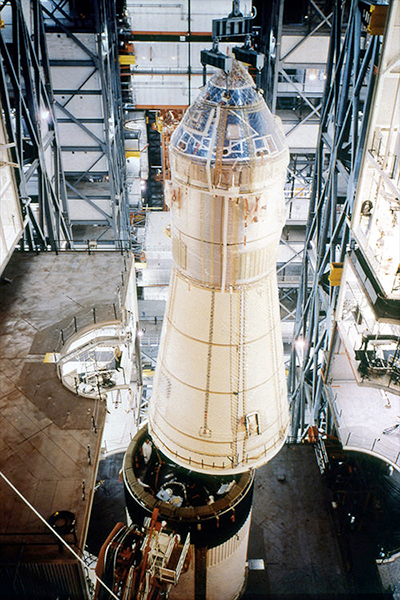 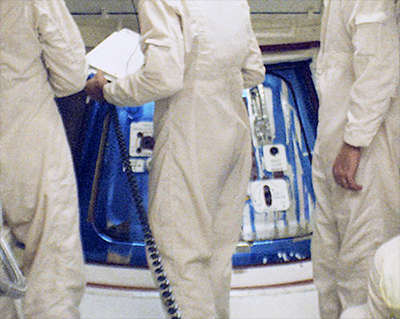
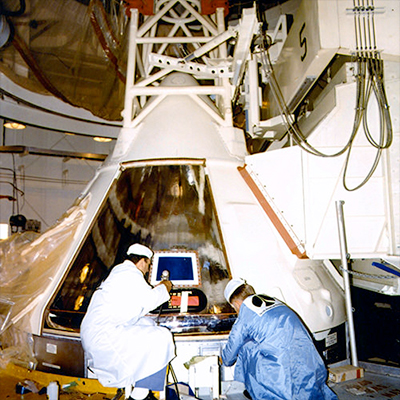
|
Paul78zephyr
Member Posts: 784
From: Hudson, MA
Registered: Jul 2005
|
 posted 08-29-2018 09:23 AM
posted 08-29-2018 09:23 AM
  
I too am intersted in an answer. Another good picture of the blue cover here: The Command Module at the Rockwell plant in Downey, Calif. on August 8, 1968 just prior to shipment to KSC. 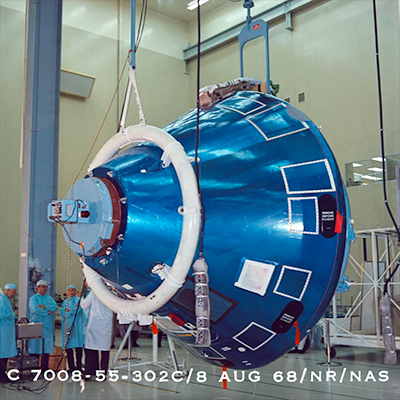 |
LM-12
Member Posts: 3723
From: Ontario, Canada
Registered: Oct 2010
|
 posted 09-08-2018 11:38 AM
posted 09-08-2018 11:38 AM
  
A post on this webpage mentions the Kapton tape and the blue protective tape on the command module. Scroll down to the 26 Aug 1997 comment. All of the Apollo Block II Command Modules were covered with aluminized Kapton tape. The Kapton is a clear plastic film (polyimide) amberish in color. A thin vaccuum depositing of aluminum was mirror bright. The adhesive was applied on the amber side so that the mirror side was out (thus the CM looks like a mirror), but, after re-entry, some of the aluminum was removed or the tape was burned and peeled up so that the remnants gave a yellowish cast. I believe that the tape was applied in 2 inch stips and it was hand done on the pad just before launch. The blue protective tape was peeled off and the Kapton tape was pieced on in sections. |
heng44
Member Posts: 3647
From: Netherlands
Registered: Nov 2001
|
 posted 09-08-2018 12:03 PM
posted 09-08-2018 12:03 PM
   
Unfortunately it doesn't say when the blue tape was removed. |
LM-12
Member Posts: 3723
From: Ontario, Canada
Registered: Oct 2010
|
 posted 09-09-2018 03:59 AM
posted 09-09-2018 03:59 AM
  
Descriptions of the command module seem to vary. Was the blue protective layer placed over the highly-reflective Kapton strips, or were the Kapton strips placed on the command module after the blue layer was removed? |
oly
Member Posts: 1436
From: Perth, Western Australia
Registered: Apr 2015
|
 posted 09-09-2018 05:41 AM
posted 09-09-2018 05:41 AM
   
The image posted above by Paul shows the blue transparent film over the Kapton tape. I am curious if this blue film is part of the tape application process to prevent tape damage, or if it was applied after tape installation. |
heng44
Member Posts: 3647
From: Netherlands
Registered: Nov 2001
|
 posted 09-09-2018 08:34 AM
posted 09-09-2018 08:34 AM
   
My friend Rolf Schoevaart has a sample of the tape and the description contains the following information: The CM thermal coating that looks like aluminum foil was G 1015 thermal control tape, comprised of 0.5 mil Kapton with a silicone pressure sensitive adhesive on the back. It was coated with about 5-millionths of an inch of vacuum deposited aluminum and overcoated with about 40-millionths of an inch of silicon oxide. The G.T. Schjeldahl Company, Northfield, Minnesota, manufactured this tape, which was supplied with a blue protective coverlay tape. So the blue protective cover had to be peeled off to expose the G 1050. The question remains: when?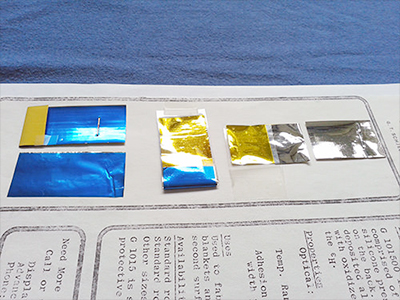 |
LM-12
Member Posts: 3723
From: Ontario, Canada
Registered: Oct 2010
|
 posted 09-09-2018 01:39 PM
posted 09-09-2018 01:39 PM
  
Wouldn't the blue protective cover on the forward heat shield of the CM have to be removed before the LES tower and forward boost protective cover were stacked on the vehicle in the VAB?Apollo 14 photo 70P-464 (below) seems to show that. Some photos taken in the MSOB and VAB show the CM forward heat shield without the blue protective cover. 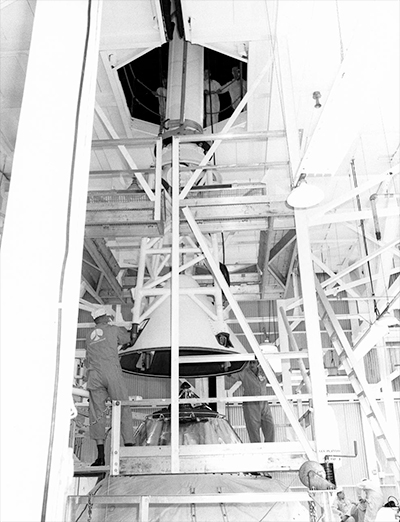 |
heng44
Member Posts: 3647
From: Netherlands
Registered: Nov 2001
|
 posted 09-09-2018 01:55 PM
posted 09-09-2018 01:55 PM
   
That seems possible, because that part could not be removed on the launch pad. But apparently the rest of the BPC could be removed in parts. And my Apollo 17 CDDT photo clearly shows the blue protection still partially in place. |
oly
Member Posts: 1436
From: Perth, Western Australia
Registered: Apr 2015
|
 posted 09-09-2018 10:15 PM
posted 09-09-2018 10:15 PM
   
quote:
Originally posted by heng44:
So the blue protective cover had to be peeled off to expose the G 1050.
Thanks for that information, It confirmed my suspicion about the blue film being a protective backing for the Kapton, which may have prevented the Kapton tape from being stretched and damaged during application.This, plus the fact that the photos indicate that NASA wanted to protect the Kapton as much as possible, tends to indicate that the blue film was left on as long as possible, and only removed when needed. The third image posted by Ed above looks to show technicians installing the access panel and sealing the heat shield joints. The blue film left on the panel may have been done to protect the Kapton tape during handling. When this image was taken is probably a good indication to the answer to this question. This also highlights that NASA may have treated the surface finish and condition of the tape with a higher level of importance than I was previously aware of. This makes sense because the original purpose of the tape was for reflective thermal protection, but I was not aware of just how critical it may have been considered, and I would be interested to find any documentation regarding this point. It would be great to hear from someone that was there at the time. |
oly
Member Posts: 1436
From: Perth, Western Australia
Registered: Apr 2015
|
 posted 09-09-2018 10:41 PM
posted 09-09-2018 10:41 PM
   
Some further investigation, the third photo posted by Ed shows the installation of the BPC. This high resolution version of that image was taken 22 July 1971, four days prior to launch.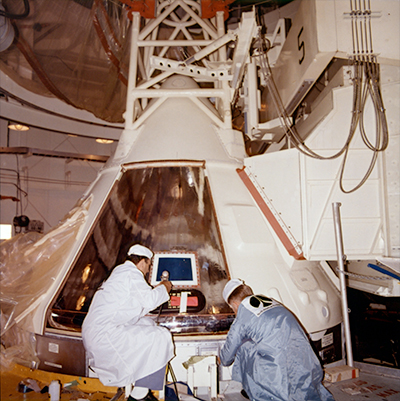 |
LM-12
Member Posts: 3723
From: Ontario, Canada
Registered: Oct 2010
|
 posted 09-10-2018 12:41 PM
posted 09-10-2018 12:41 PM
  
The blue film appears to have been removed from the CM hatch area seen in this Apollo 11 CDDT photo KSC-69PC-337 dated July 3, 1969.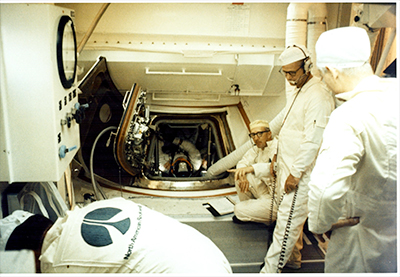 |
space1
Member Posts: 922
From: Danville, Ohio
Registered: Dec 2002
|
 posted 09-10-2018 01:28 PM
posted 09-10-2018 01:28 PM
   
Here is the North American Aviation specification, Application of Apollo Command Module Thermal Control Coating. Lots of interesting details.Paragraphs 3.3 and 4.2.3 indicate that the protective film is not to be removed until just before installation of the Boost Protective Cover. |
heng44
Member Posts: 3647
From: Netherlands
Registered: Nov 2001
|
 posted 09-10-2018 02:16 PM
posted 09-10-2018 02:16 PM
   
Very interesting. You would expect that "just before the installation of the boost protective cover" would mean prior to rollout. But apparently the BPC can be partially removed at the launch pad. That would mean the blue film can be removed just prior to launch, although on some flights it looks as though it was done before the CDDT. |
LM-12
Member Posts: 3723
From: Ontario, Canada
Registered: Oct 2010
|
 posted 09-10-2018 03:24 PM
posted 09-10-2018 03:24 PM
  
One thing puzzles me about a few of the photos mentioned so far.Looking at the Apollo 15 photo, it seems that the forward BPC that covers the forward heat shield would have to be installed before the aft (lower) BPC that covers the crew compartment heat shield. But the Apollo 14 VAB photo shows the forward boost protective cover being lowered onto the command module, with the crew compartment section already covered by the white, tarp-like thermal cover seen in rollout photos. Was the aft BPC installed for the rollout from the VAB to the pad? |
mode1charlie
Member Posts: 1395
From: Honolulu, HI
Registered: Sep 2010
|
 posted 09-10-2018 03:25 PM
posted 09-10-2018 03:25 PM
   
Does anyone happen to know if this particular material — G 1015 thermal control tape — is still being made? I'm aware that kapton tape is, but I'd be interested to see what the blue cover film and underlying silver color looks like up close. |
Paul78zephyr
Member Posts: 784
From: Hudson, MA
Registered: Jul 2005
|
 posted 09-10-2018 07:59 PM
posted 09-10-2018 07:59 PM
  
quote:
Originally posted by heng44:
My friend Rolf Schoevaart has a sample...
Do you know if the G 1015 material as noted by your friend is the same as the GT-131 material in John's (space1) document? |
oly
Member Posts: 1436
From: Perth, Western Australia
Registered: Apr 2015
|
 posted 09-11-2018 01:09 AM
posted 09-11-2018 01:09 AM
   
quote:
Originally posted by LM-12:
...it seems that the forward BPC that covers the forward heat shield would have to be installed before the aft (lower) BPC that covers the crew compartment heat shield.
I am also curious about this, is there a photo of a complete BPC that is not installed? Does the whole assembly come off as one piece during jettison or do the lower sections fall away similar to payload fairings, with the small upper cone attached to the tower? |
heng44
Member Posts: 3647
From: Netherlands
Registered: Nov 2001
|
 posted 09-11-2018 04:10 AM
posted 09-11-2018 04:10 AM
   
quote:
Originally posted by Paul78zephyr:
Do you know if the G 1015 material as noted by your friend is the same as the GT-131 material in John's (space1) document?
Not sure. The NAA document that John provided is dated 1966, so does that mean it is referring to Block I CMs? I have never seen any evidence of this type of protective material in Apollo 1 photos. |
heng44
Member Posts: 3647
From: Netherlands
Registered: Nov 2001
|
 posted 09-11-2018 04:16 AM
posted 09-11-2018 04:16 AM
   
quote:
Originally posted by LM-12:
Was the aft BPC installed for the rollout from the VAB to the pad?
Isn't it possible that only the forward BPC was installed for rollout (with the blue tape already removed)? And the rest of the BPC would then be installed at the pad. That would explain why the spacecraft was protected by a tarp at rollout. |
LM-12
Member Posts: 3723
From: Ontario, Canada
Registered: Oct 2010
|
 posted 09-11-2018 04:21 AM
posted 09-11-2018 04:21 AM
  
Yes, that was my line of thinking. Otherwise, they would have had to install the aft BPC twice. |
oly
Member Posts: 1436
From: Perth, Western Australia
Registered: Apr 2015
|
 posted 09-11-2018 07:35 AM
posted 09-11-2018 07:35 AM
   
There will be a list of items that are installed, connected or armed at the last opportunity. Items such as batteries, pyros, squibs, perhaps gas cylinders needing charge or top up. There must be a list of items done in the days leading up to launch. As the image of the technicians working on the CSM with the BPC partially removed was taken four days prior to launch, this narrows the window down to between T minus 4 days, and T Zero. |
LM-12
Member Posts: 3723
From: Ontario, Canada
Registered: Oct 2010
|
 posted 09-11-2018 12:57 PM
posted 09-11-2018 12:57 PM
  
It looks like there was also some reflective tape on the lower part of the Skylab command modules, as seen in Skylab 3 recovery photo S73-36435.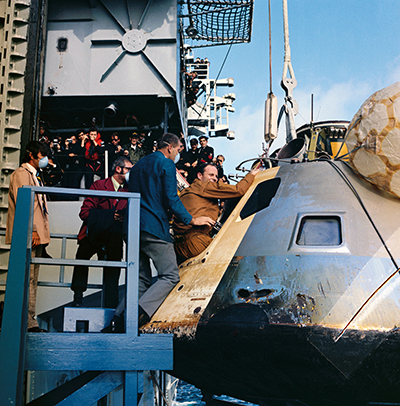 |
heng44
Member Posts: 3647
From: Netherlands
Registered: Nov 2001
|
 posted 09-11-2018 01:21 PM
posted 09-11-2018 01:21 PM
   
You are not referring to the tape on the negative at lower right, are you? 
|
LM-12
Member Posts: 3723
From: Ontario, Canada
Registered: Oct 2010
|
 posted 09-11-2018 01:51 PM
posted 09-11-2018 01:51 PM
  
I was referring to the tape that is seen peeling off the command module. |
LM-12
Member Posts: 3723
From: Ontario, Canada
Registered: Oct 2010
|
 posted 09-14-2018 10:18 PM
posted 09-14-2018 10:18 PM
  
Apollo 7 photo 68-H-536 shows that there was a flag on the blue film near window number 1.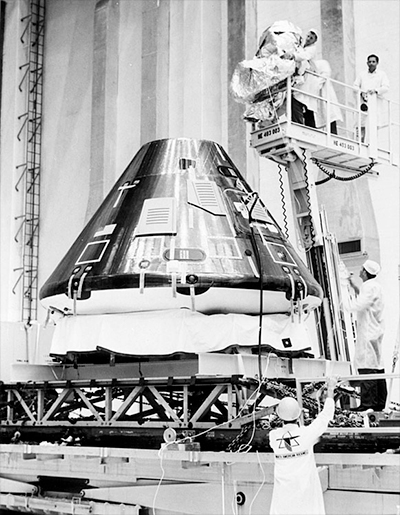 |
LM-12
Member Posts: 3723
From: Ontario, Canada
Registered: Oct 2010
|
 posted 09-21-2018 11:52 AM
posted 09-21-2018 11:52 AM
  
ASTP photo KSC-75P-0015 was taken in the MSOB altitude chamber. The CM does not seem to have the blue film or the reflective tape on the heat shield. The docking module and Apollo spacecraft for this summer's joint manned mission with the Soviet Union were mated in the Manned Spacecraft Operations Building today. The docking module will provide a mechanical and electrical link between the Apollo and Soyuz spacecraft while they are docked and also serve as an airlock. On hand to participate in the operation were two members of the Apollo prime crew, Astronauts Donald K. Slayton and Vance D. Brand. launch of the Saturn 1B/Apollo from Complex 39 is scheduled for July 15. 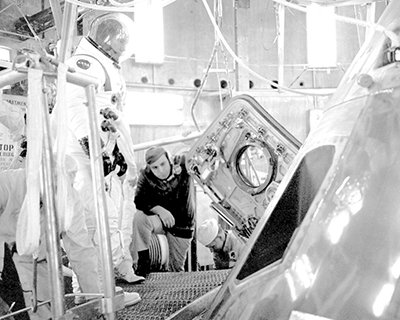 Here is a KSC arrival photo of the ASTP command module. 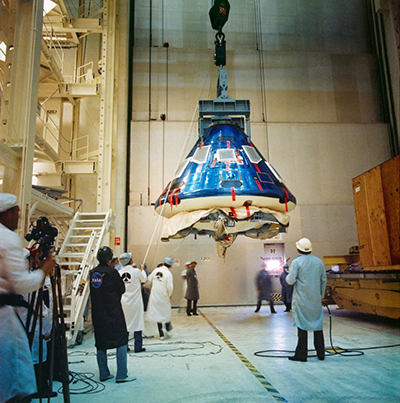 |
heng44
Member Posts: 3647
From: Netherlands
Registered: Nov 2001
|
 posted 09-23-2018 01:26 PM
posted 09-23-2018 01:26 PM
   
ASTP CM-DM docking test in the KSC altitude chamber, January 27, 1975.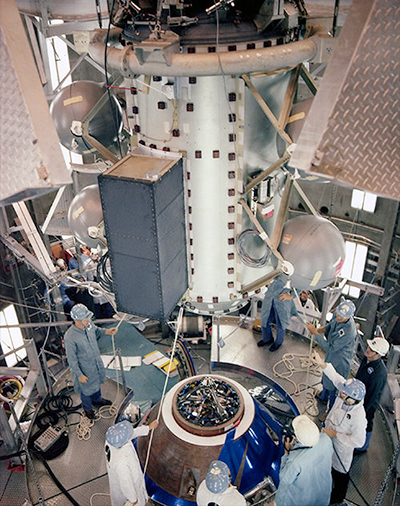 ASTP Apollo spacecraft being prepared for mating to SLA, March 5, 1975. 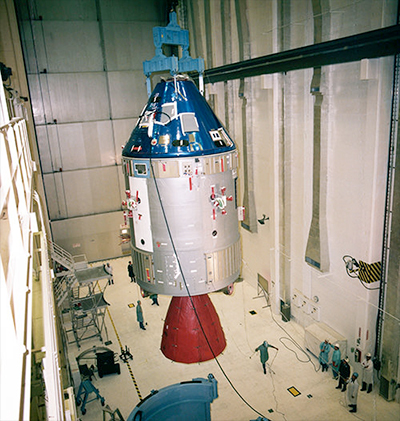 |
LM-12
Member Posts: 3723
From: Ontario, Canada
Registered: Oct 2010
|
 posted 09-23-2018 01:46 PM
posted 09-23-2018 01:46 PM
  
I was wondering what a color photo of the ASTP command module in the altitude chamber would look like. So it appears that some of the blue film was removed from the forward heat shield, and there is no reflective tape there.In my black and white photo, I see a reflective surface (the blue film probably) on the crew compartment section to the right of window 4. That seems to agree with your color photo. Hard to tell with black and white photos, but there seems to be even more of the blue film removed in photo 75-H-124, which has the caption: The Apollo Soyuz Test Project (ASTP) prime crew of astronauts Slayton, Brand and Stafford go through an altitude chamber run in the Command Service module. 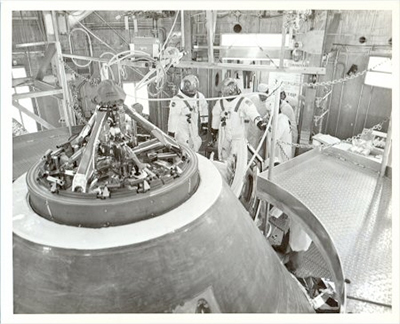 |
oly
Member Posts: 1436
From: Perth, Western Australia
Registered: Apr 2015
|
 posted 09-23-2018 08:06 PM
posted 09-23-2018 08:06 PM
   
quote:
Originally posted by LM-12:
So it appears that some of the blue film was removed from the forward heat shield, and there is no reflective tape there.
As detailed in the document provided previously by John (space1), the blue film is a protective layer of the silver reflective tape, so it is essentially on in the same. The ASTP CM-DM docking test in the KSC altitude chamber photo taken from overhead appears to show the task of applying the reflective Kapton as underway, but not complete during this test.There could be numerous reasons why this was done, or also reasons why the tape was applied to these specific reasons prior to the test. What has become apparent during this thread is the format of the tape, having the blue film as part of the silver reflective tape, and also how detailed and time consuming the application of the tape, and the removal of the blue film, must have been. Each individual piece of tape was cut from a pattern, and applied to it's respective location. This means that each piece of blue film would need to be removed individually. Anyone who has experienced losing the end of the roll of packing tape or gift wrapping tape could sympathise over this task. It seems that the application of the reflective tape required a methodical, detailed procedure to prevent wrinkles, creases and trapped air bubbles. The silver coating was thin film aluminum. any stretching of the tape may result in this coating being damaged, and any scratches or nicks would compromise the finish. Any blemishes, such as finger prints or stains, would compromise the reflective quality and so effect the thermal protection during spaceflight. Anyone who has worked with pure Aluminum will be aware how fast the surface oxidates with exposure to air. the longer the protective blue film was left on the command module, the higher the quality of the reflective surface would be during flight. Prior to Ed posting this question, I had always assumed that the blue film was a single sheet of material, as it had been referred to as looking like a cellophane wrapping in news articles and interviews [gumdrop]. I am still looking for information on the Boost Protective Cover layout, which would help explain the sequence of events better. Are there any surviving examples of the BPC on display that show how it was assembled and secured? |
LM-12
Member Posts: 3723
From: Ontario, Canada
Registered: Oct 2010
|
 posted 09-23-2018 09:09 PM
posted 09-23-2018 09:09 PM
  
But a blue film was already on the ASTP command module when it arrived at KSC, as seen in the KSC arrival photo linked earlier. Some of that blue film is "missing" in the altitude chamber photo. Missing, therefore removed at some point after arrival. |
oly
Member Posts: 1436
From: Perth, Western Australia
Registered: Apr 2015
|
 posted 09-24-2018 05:36 AM
posted 09-24-2018 05:36 AM
   
Where is the altitude chamber located that these tests were performed in? Could it the case that the remainder of the film installed after the chamber tests and prior to shipment to the cape?Or perhaps there was a fault that required the reflective tape removal or replacement? |
LM-12
Member Posts: 3723
From: Ontario, Canada
Registered: Oct 2010
|
 posted 09-24-2018 05:41 AM
posted 09-24-2018 05:41 AM
  
The altitude chamber in the photo is located at KSC in the Manned Spacecraft Operations Building.Here is another view of the ASTP command module in the KSC altitude chamber. (The person at top right may very well have taken the photo that Ed posted.)  |
LM-12
Member Posts: 3723
From: Ontario, Canada
Registered: Oct 2010
|
 posted 09-24-2018 05:01 PM
posted 09-24-2018 05:01 PM
  
quote:
Originally posted by LM-12:
there seems to be even more of the blue film removed in photo 75-H-124
There is a color film clip similar to the photo that shows Vance Brand entering the CM in the altitude chamber. It also shows the forward heat shield with no blue film and no reflective tape. All the blue film seen in Ed's photo is not there.I think the clip footage pre-dates Ed's photo. Going even further back, I would like to see a color photo of what the ASTP command module looked like when it was placed inside the altitude chamber. |
oly
Member Posts: 1436
From: Perth, Western Australia
Registered: Apr 2015
|
 posted 09-25-2018 07:15 PM
posted 09-25-2018 07:15 PM
   
I have looked online to clarify this but can't find a definitive answer. Was the ASTP CM completely covered with the Kapton tape while on orbit, or was part of the CM painted in a similar method to the Skylab command modules?The film of the splashdown and recovery of the CM does not reveal a definitive answer to this, and the photos on orbit, available online, do not have the resolution to clear this question up. North American reinforced repeatedly the requirement for the Kapton film integrity to prevent the Avcoat absorbing moisture. The CM certification process required the film to be installed before the capsule was shipped. If this material was removed at KSC, the removal of some of this material, and the reason for it, must have been documented at some time. If the CM did have a painted area, this may explain why the Kapton was removed. |
LM-12
Member Posts: 3723
From: Ontario, Canada
Registered: Oct 2010
|
 posted 09-26-2018 11:29 AM
posted 09-26-2018 11:29 AM
  
quote:
Originally posted by oly:
The CM certification process required the film to be installed before the capsule was shipped.
Perhaps for ASTP it was different, and for some reason it was necessary to apply the reflective thermal tape at KSC instead. Is it possible that the blue protective film seen in the KSC arrival photo was applied directly to the heat shield, and removed some time after arrival? Is the resolution of the arrival photo good enough to determine with any certainty whether there was or was not reflective thermal tape under the blue film?
|
oly
Member Posts: 1436
From: Perth, Western Australia
Registered: Apr 2015
|
 posted 09-26-2018 09:07 PM
posted 09-26-2018 09:07 PM
   
The decision in 1968 to halt the process of painting the completed command module exterior surface with a protective enamel paint meant that the Avcoat material required another method of moisture barrier.The brazed stainless-steel sandwich panels that make up the heat shield, manufactured by North American Aviation subcontractor, Aeronca Corp, were shipped to Avco Corp for the application of the ablator material. A fiberglass honeycomb core was bonded to the primed stainless steel, vacuum bagged, cured and inspected using eddy-current process. The ablator material was hand pumped [at 160 degrees F] into the 3/8 inch honeycomb cells. The structure was then oven cured and post-cured before being x-ray inspected, and any voids or defects were repaired by hand. The structure was then machined using a numerically controlled lathe to give the varying thickness profiles around the circumference of the structure, tapering from the base. Post machining thickness inspections were measured using eddy-current process before various fixtures and fittings were installed to the heat shield. Silicone rubber gaskets were installed as required, and a final moisture content check was performed before a thin epoxy-based pore sealed was applied to the porous ablator material. Final weight and centre of gravity measurements were performed before a moisture protecting plastic coating was applied before shipment back to North American, where the heat shield sub-assemblies are installed to the spacecraft. "Before the CM is shipped from the prime contractor site to the NASA John F. Kennedy Space Center (KSC), the plastic coating is stripped off and the thermal-control coating with an adhesive backing is attached to the CM." Specifications for maximum moisture content of the ablator material was 2 percent. The boost protective cover was a multi-layer, resin-impregnated fiberglass assembly that fits over the command module like a glove. Each cover was tailored to each heat shield. The process required the heat shield to be mounted on a holding fixture and a mixture of resin and fiberglass blown against the shield to produce a fiberglass female mold identical to the heat shield. Through a series of carefully controlled casting operations, a full-size plaster master is constructed to reproduce the outer mold line of the heat shield. This process resulted in plaster simulators that match so exactly the actual heat shield, "that the finished boost protective cover was inspected for a match with the simulator rather than the actual heat shield, eliminating hundreds of hours of inspection and other operations for the spacecraft." The reflective external thermal coating was rated as capable of rejecting 100 degrees F of radiant heating. With so many checks and limits applied to the manufacture of the thermal protection system, and critical limits applied to moisture content and reflective quality of the Kapton material, it would be highly unlikely that the manufacturing contractors, sub-contractors, or NASA would welcome a deviation from specification and procedure. Florida is not conducive to a moisture-free environment, and the Apollo Soyuz command module had been completed sometime before the final Apollo mission. CSM-111, used for the ASTP mission, was used as an acoustic test platform, and also as a test bed for the Skylab rescue vehicle modifications. This serial number slots between Apollo 14 and 15 missions, indicating that it was taken out of sequence. It would be more probable that the Kapton material may have been damaged or deteriorated during the many tests during the acoustic, Rescue, and ASTP docking module fit checks, or that the moisture content may have been compromised at some time, however, I am not aware of these issues. As I queried earlier, while I do not believe it to be the case, there may be the possibility that the ASTP CM had a painted exterior section in a hybrid combination of Apollo and Skylab styles. |
LM-12
Member Posts: 3723
From: Ontario, Canada
Registered: Oct 2010
|
 posted 09-26-2018 10:53 PM
posted 09-26-2018 10:53 PM
  
The whole surface of the ASTP command module looks mirror-like to me.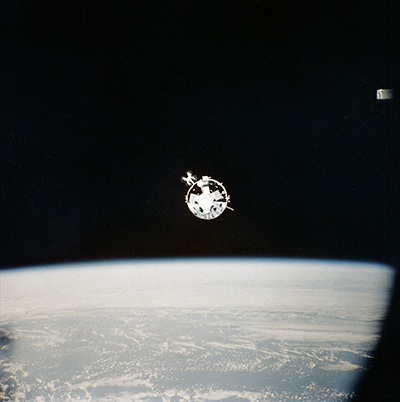 |
oly
Member Posts: 1436
From: Perth, Western Australia
Registered: Apr 2015
|
 posted 09-27-2018 01:12 AM
posted 09-27-2018 01:12 AM
   
The TIF version of your image is a higher resolution image, and even when downloaded and viewed in image processing software I could not definitively confirm the surface finish of the command module. This image gives better detail and still does not confirm the detail. 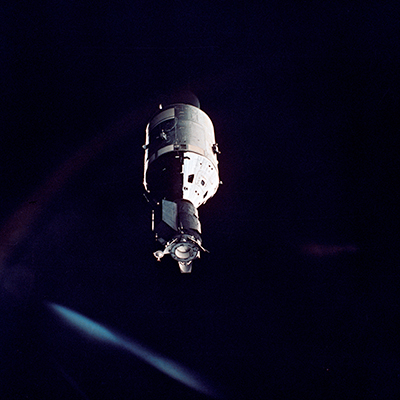 Every detailed image of the command module post flight shows the same side. Or the dark section of the command module is always opposite the hatch. If we consider that the whole command module was covered with the silver reflective Kapton tape during the mission, the reason why it appears that the CM arrived at KSC, is photographed with some material removed, and photographed later with it restored still indicates an aberration to standard procedures that seem to be unique to ASTP and contradict NASA document TN D-7564 Apollo Experience Report: Thermal Protection Subsystems. |
LM-12
Member Posts: 3723
From: Ontario, Canada
Registered: Oct 2010
|
 posted 09-27-2018 05:06 AM
posted 09-27-2018 05:06 AM
  
Looking at those photos reminds me of some of the Apollo 9 images. The Apollo 9 CM had the silver reflective tape all over, but it did appear to be "black" in several images, including AS09-24-3633.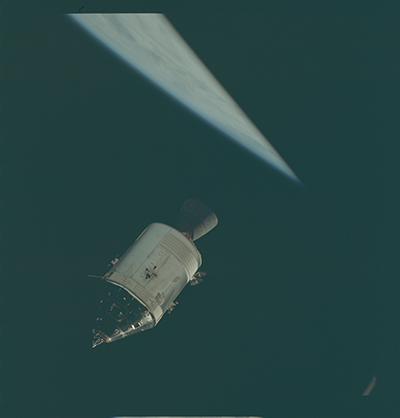 In Ed's altitude chamber image, we can see some reflective tape with blue film being applied to the side opposite the hatch, the side that appears dark in the orbit photos of the ASTP command module. |































